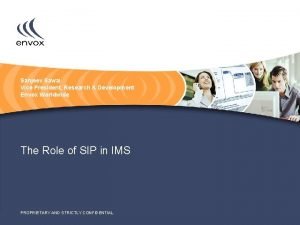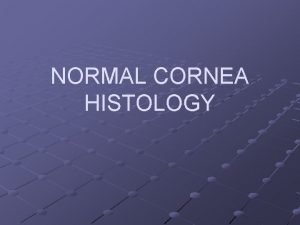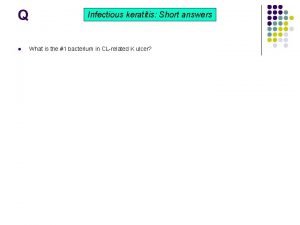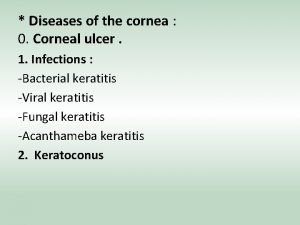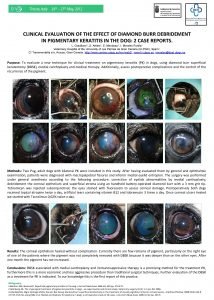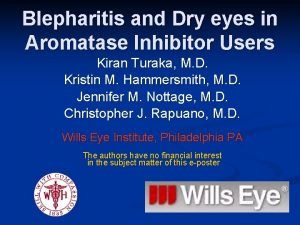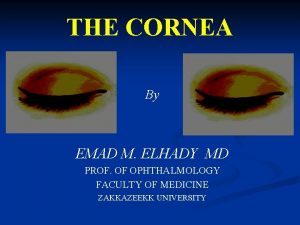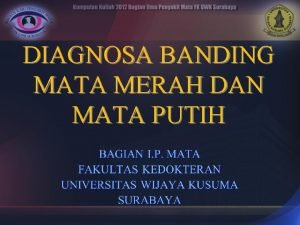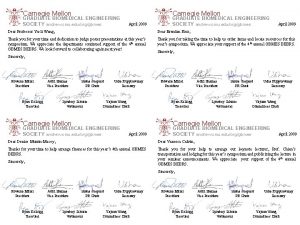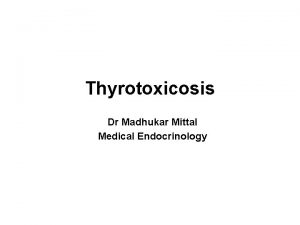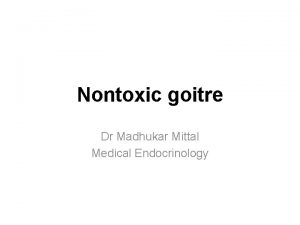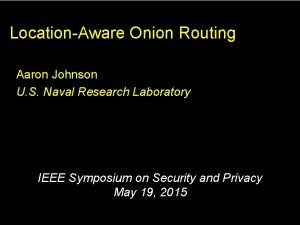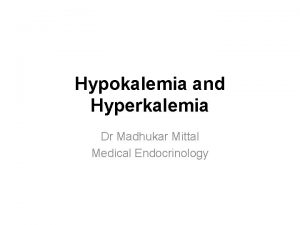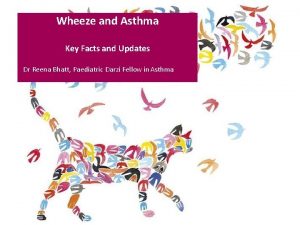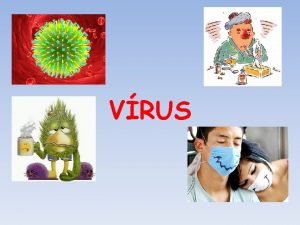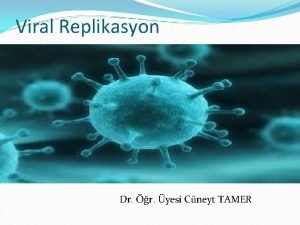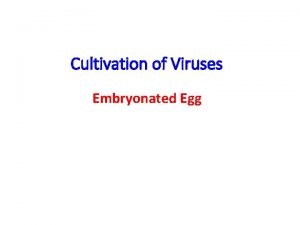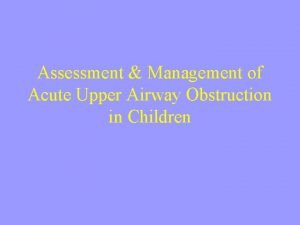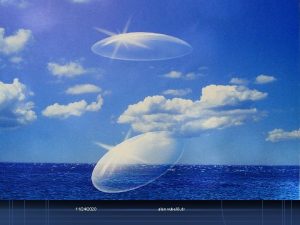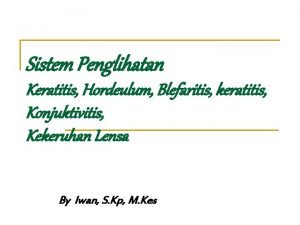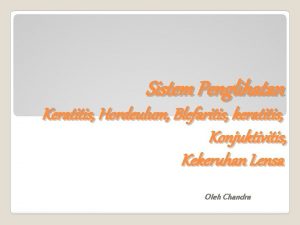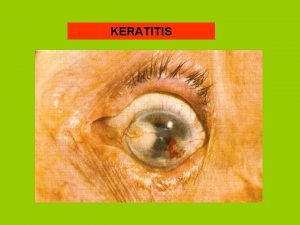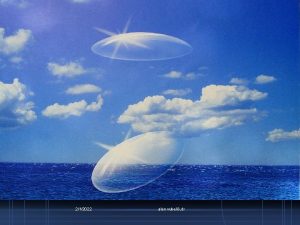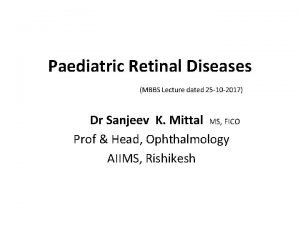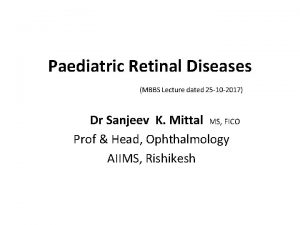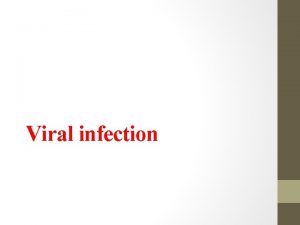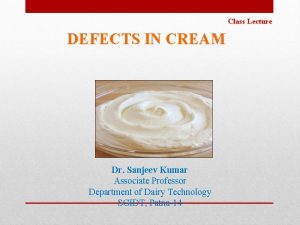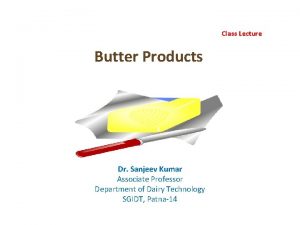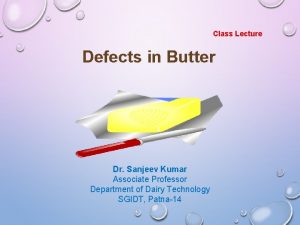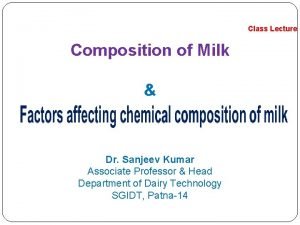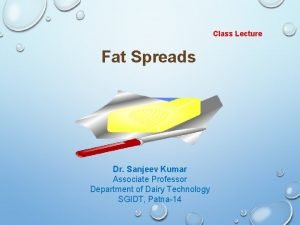VIRAL AND PROTOZOAL KERATITIS Dr Sanjeev Kumar Mittal

































- Slides: 33

VIRAL AND PROTOZOAL KERATITIS Dr Sanjeev Kumar Mittal Professor & Head, Ophthalmology 13 -02 -2018

HERPES VIRUS �Are ubiquitous human pathogen capable of causing both asymptomatic infection and active disease �Humans are natural reservoir of HSV � 2 types – HSV 1 - oropharynx HSV 2 – genital area �Ocular disease typically caused by type 1 �Causes primary infection in children and neonates MODE OF INFECTION: � IP – 3 - 9 days �HSV 1 – close contact �HSV 2 – venereal – birth canal

MECHANISM OF ACTION � HSV (epitheliotropic & cytolytic) binds to one or more cellular receptor – heparin sulphate �Virus fuses with cell membrane �Enters the cell and nucleus where the transcription of viral DNA occurs – protein

• TG is the most common source of recurrent HSV infection. • Primary infection may subsequently reactivate by travelling via ophthalmic division of 5 th CN to the eye.

PATHOGENESIS Factors for reactivation – �UV rays �Trauma �Heat, abnormal body temperature �Other infectious disease �Emotional disease �Menstrual stress �Steroids, immunosuppresant, PGs

CLINICAL FEATURES Suspicion of viral keratitis arises if there is �Associated skin lesions, recurrences of these lesions �Stress-induced recurrence �Immuno compromised status �History of contact �Symptomatic eye (Pain , Photophobia , Blurred vision, Tearing , Redness) with minimal conjunctival and corneal signs �Superficial dendrites with loss of corneal sensation

CLASSIFICATION OF OCULAR DISEASE � 1. Congenital & Neonatal � 2. Primary infection � 3. Recurrent infection

CONGENITAL AND NEONATAL OCULAR HERPES May be acquired by one of the three periods : q Intrauterine (5%) q Peripartum(10%) q Postpartum (85%) �Intrauterine infection occurs in 1/300, 000 births, with features of microophthalmia, retinal dysplasia, optic atrophy and chorioretinitis. �HSV infections in latter two periods are further classified as skin, eyes, or mouth (SEM) with or without the other involvement seen in intrauterine infections. �Ocular herpes include one or all: conjunctivitis, epithelial keratitis, stromal immune reaction, cataract, necrotizing chrioretinitis.

PRIMARY INFECTION �After 6 months – maternal anti-HSV Ig. G �Cutaneous involvement−vesicular periocular skin involvement eruptions , vesicular ulcerative blepharitis �Acute follicular conjunctivitis �Keratoconjuctivitis with non-suppurative lymphadenopathy �Diffuse punctate keratitis – that evolves into multiple scattered micro dendrite figures. �As a rule confined to epithelium clinically – d/t lack of previous immunologic stimulus Treatment-Topical antivirals supported by antibiotics & cycloplegics

RECURRENT INFECTION �Patients with recurrent herpes have both cellular and humoral immunity against the virus. corneal vesicles dendritic ulcer geographic ulcer(amoeboid) limbal ulcer (marginal)

CLASSIFICATION OF HSV KERATITIS �The disease may present as any one or a combination of the following: 1. Blepharoconjuctivitis 2. Episcleritis, scleritis 3. Infectious epithelial keratitis –(IEK) 4. Neurotrophic keratopathy 5. Stromal keratitis Necrotizing stromal keratitis Immune (interstitial) keratitis Immune rings Limbal vasculitis Disciform keratitis 6. Endothelitis Disciform Diffuse Linear 7. Iridocyclitis 8. Trabeculitis

Herpes simplex epithelial keratitis MC PRESENTATION • Dendritic ulcer with terminal bulbs • May enlarge to become geographic • Stains with fluorescein In herpes, corneal sensation is reduced in approx 70 % of the patient. Treatment • Aciclovir 3% ointment x 5 daily • Ganciclovir ophthalmic gel 0. 15% - 5 times daily • Supported by antibiotics and cycloplegics • Debridement if non-compliant 2 -3 wks

D/D OF DENDRITIC KERATITIS • Herpes zoster dendritic keratitis (pseudodendrites) • Acanthamoeba keratitis • Contact lens keratopathy • Antiviral toxicity

Herpes simplex disciform keratitis Signs Associations • Central epithelial and stromal oedema • Occasionally surrounded by Wessely ring • Folds in Descemet membrane • Small keratic precipitates Treatment - topical steroids (pred 1% or dexa 0. 1%)+ with antiviral cover

COTND…. �Oral (in immunodeficient or children) : : Acyclovir 400 mg PO 5 t/d * 14 days, or : : Famcyclovir 500 mg PO twice daily for 14 days, or : : Valacyclovir 500 mg PO twice daily for 14 days, or

Neurotrophic keratopathy ( Metaherpetic) �Damage to gasserian ganglion �Impaired corneal innervations �Decreased tear secretion �Excess use of antivirals Signs – �Irregular cornea with loss of corneal lustre �Characterized by persistent epithelial defect �Oval in shape with gray, thickened smooth borders Rx-Stop all unnecessary medications Gentle debridement of boggy epithelium Artificial tears Mild steroid : If active stromal keratitis +ve Therapeutic soft CL Doxycycline 100 mg PO once daily to inhibit collagenase Cycloplegics: if iritis is +ve Tarsorrhaphy to treat chronic exposure Cyanoacrylate glue – if perforation occurs

PRIMARILY A CLINICAL DIAGNOSIS LABORATORY INVESTIGATIONS Specific tests �Viral culture (gold standard) �Antigen detection – Immunofluorescence, Elisa �PCR �Serology Non-specific tests – �Cytology --Giemsa stain (multinucleated giant cells ) --Papanicolaou stain - intranuclear eosinophilic inclusion bodies �Electron microscopy

INDICATIONS FOR ORAL ACYCLOVIR Oral Acyclovir �Linear endothelitis �Diffuse endothelitis �Severe trabeculitis �Immunocompromised patients �Paediatric patients refractory to topical �Prophylaxis for post-PKP with h/o HSV �Prophylaxis against recurrent IEK

PROPHYLAXIS AGAINST RECURRENCE : : Frequent recurrent infection if b/l or involving an only eye : : Post –PK patients with history of HSV keratitis �Tab acyclovir 400 mg BD * 12 - 18 months �Tab famcyclovir 250 mg OD * 12 -18 months � Valacyclovir 500 mg OD * 12 - 18 months (for immunocompromised pt)

VARICELLA ZOSTER VIRUS �Incidence & epidemiology: I. Spread by saliva droplets, or direct contact with infected rash. II. The maculopapular rash appears in successive crops, lesions of various stages present simultaneously. III. Contagious period approx 1 day before rash & continues approx 1 week after app of each crop of lesion or until the cutaneous sores crust over. IV. IP: 12 - 17 days after contact.

CLINICAL DISEASE �Congenital varicella syndrome q. If mother contracts varicella during first or second trimester of pregnancy. q. Ocular findings ~ chorioretinits, optic nerve atrophy or hypoplasia, congenital cataract and Horner Syndrome. q. No specific treatment. q. Vaccinate all women with no history of previous varicella.

HZO • First described by Hutchinson in 1865 • MC involves ophthalmic division of 5 th nerve • Frontal branch is MC involved • Nasociliary involvement – 76% ocular involvement • Hutchinson’s sign – vesicles at the side & tip of nose precedes HZO • HZO lies dormant in TG

Herpes zoster keratitis Acute epithelial keratitis Nummular keratitis • Develops in about 50% within • Develops in about 30% within 2 days of rash 10 days of rash • Small, fine, dendritic or stellate • Multiple, fine, granular deposits epithelial lesions just beneath Bowman membrane • Tapered ends without bulbs • Halo of stromal haze • Resolves within a few days • May become chronic

OPHTHALMIC COMPLICATIONS �Ramsay Hunt syndrome – 7 th nerve palsy + loss of taste over ant 2/3 rd tongue + earpain + vesicles in external auditory canal or pinna

DIAGNOSIS �Diagnosis based on acute or recent history of systemic ds with ocular or periocular involvement with vesicles. INVESTIGATIONS- vesicular fluid for PCR, immunomicroscopy

TREATMENT � ACTIVE DISEASE 1. Antivirals( treat for 7 days , starting within 72 hrs) Famcyciclovir 500 mg PO TDS Valacyclovir 1 g PO TDS Acyclovir 800 mg PO 5 t/d 2. Lesions of lid, conjunctiva or cornea ( dendritic or rarely geographical keratitis) – topical AV (trifluridine applied 9 t/d * 7 -10 days) plus an topical AB. 3. Late onset immune stromal ds treated similar to stromal herpes infection. 4. Pain prevention- TCA’s( eg nortryptyline, desipramine) 25 -75 mg PO * 3 months Nonnarcotic or short term narcotic analgesic. 5. Immunocompromised patients with any zoster – I. V Acyclovir 15 – 20 mg/kg/day

ADENOVIRUS KERATOCONJUCTIVITIS �Medium-sized (90– 100 nm), � nonenveloped (without an outer lipid bilayer) icosahedral viruses composed of a nucleocapsid and a double-stranded linear DNA genome. �OCULAR MANIFESTATIONS 1. Epidemic keratoconjunctivits 2. Pharyngoconjunctival fever 3. Nonspecific follicular conjunctivitis 4. Chronic adenoviral keratoconjunctivitis

EPIDEMIC KERATOCONJUCTIVIS �Serotype AD 8, 19, & 37. � Most serious adenoviral ocular illness �In young adults during the fall and winter months �U/L in 2/3 rd pt �IP 8 days �Sign and symptoms: Acute tearing, FBS, photophobia, followed by lid and conjuctival edema and hyperemia, follicular and papillary conjuctival response with or without hge or membrane formation, & tender LN’s

PHARYNGOCONJUCTIVAL FEVER CHRONIC ADENOVIRAL KERATOCONJUCTIVITIS � Serotype Ad 3 and 7 �Serotype Ad 2, 3, 4 and 19. �Similar to EKC except that the keratitis is usaully mild and b/l, and subepithelial infiltrates are less frequent and more transient. �Uncommon, often recognized cause of ant segment inflammatory and scarring ds.

DIAGNOSIS & TREATMENT �Cytologic scrappings - mixed lymphocytic and neutrophil infiltrate and degenerated epithelial cells. �Giemsa staining may reveal early eosinophillic intranuclear bodies. �Antivirals are ineffective , except cidofovir. �Topicals NSIAD’S : relief of inflammation. No effect onviral replication or appearance of corneal infiltrates. �Cycloplegics as needed for iritis. �Topical antibiotic ointment to lubricate and protect the cornea in presence of membranes. �Ice packs, antipyretics and dark glasses as needed.

ACANTHAMOEBA �Genus Acanthamoeba: - a family of free-living, ubiquitous cyst-forming protozoans. • Life cycle: - 2 forms • Generally rare infection characterized by periodic outbreaks

Acanthamoeba keratitis • Contact lens wearers at particular risk • Symptoms worse than signs • Pain disproportionate to clinical signs in early presentation CORNEAL SCRAPINGS Small, patchy anterior stromal infiltrates Perineural infiltrates (radial keratoneuritis) Epithelial scrapings for LM • H & E stain • Giemsa • PAS stain • CFW stain • Acridine orange stain CULTURE Non-nutrient agar with e. coli Ulceration, ring abscess Stromal opacification & small, satellite lesions -Medical therapy given for 135 days Treatment -Biguanides(chlorhexidine or polyhexamethylenebiguanide (0. 02%) effective against both forms

Source �Text-Kanski, Parson’s, Samar Basak, Pradeep Sharma �Photographs- above , Archives & Website
 Hutchinson sign eye
Hutchinson sign eye Dr sanjeev chatni
Dr sanjeev chatni Sanjeev sawai
Sanjeev sawai Dr. sanjeev mehrotra
Dr. sanjeev mehrotra Sanjeev khemani
Sanjeev khemani Normal cornea histology
Normal cornea histology Dendritic keratitis
Dendritic keratitis Dendritic keratitis
Dendritic keratitis Herpes zoster
Herpes zoster Dendritic keratitis
Dendritic keratitis Diamond burr keratectomy dog
Diamond burr keratectomy dog Punctate keratitis
Punctate keratitis Corneal nebulae
Corneal nebulae Diagnosis banding mata merah
Diagnosis banding mata merah Leena mittal
Leena mittal Lga to pie
Lga to pie Rowena mittal
Rowena mittal Bhumika mittal
Bhumika mittal Dr madhukar mittal
Dr madhukar mittal Pizillos method
Pizillos method Prateek mittal
Prateek mittal Hypoaldosteronism
Hypoaldosteronism 4 types of trust
4 types of trust Arcelor mittal net
Arcelor mittal net Rajat mittal
Rajat mittal Ipo readiness roadmap
Ipo readiness roadmap Section 24-1 viral structure and replication
Section 24-1 viral structure and replication Aerochamber definition
Aerochamber definition Replicação viral ciclo lítico e lisogênico
Replicação viral ciclo lítico e lisogênico Viral replikasyon basamakları
Viral replikasyon basamakları Method of cultivation of virus
Method of cultivation of virus Viral inoculation in embryonated egg
Viral inoculation in embryonated egg Egg inoculation technique
Egg inoculation technique Spasmodic croup vs viral croup
Spasmodic croup vs viral croup


